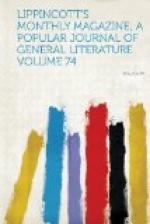OUR EARLY NEWSPAPERS.
In looking over the contents of the old newspapers of this country, of which there was a considerable number as early as the year 1730, one is specially struck by the number of advertisements of slave sales and of runaway slaves, apprentices and servants. The following are common examples:
“To be sold, a very likely Negro woman about 30 years of Age, has been in this city about 10. She is a fine Cook, has been brought up to all sorts of House Work, and speaks very good English. She has had the small Pox, and has now a Young Child. Enquire further concerning her and the Conditions of Sale of Mary Kippen, or the Printer hereof.”—New York Weekly Journal, May 9, 1735.
“Just arrived from Great Britain, and are to be Sold on board the Ship Alice and Elizabeth, Capt. Paine Commander several likely Welch and English Servant Men, most of them Tradesmen. Whoever inclines to purchase any of them may agree with said Commander, or Mr. Thomas Noble, Merchant, at Mr. Hazard’s, in New York; where also is to be Sold several Negro Girls and a Negro Boy, and likewise good Cheshire Cheese.”—New York Gazette, Sept. 11, 1732.
Here is a notice from the same paper, date 1735, which shows very clearly the position of the apprentice one hundred and forty years ago:
“Run away on the 5th. Instant from John Bell of the city of New York Carpenter, an Apprentice Boy named James Harding, aged about 19 years, being a tall well-set Lad of a Fresh Complexion, he wears a Wig, he is spley-footed and shuffles with his feet as he Walks, has a Copper coloured Kersey Coat with large flat white Mettle Buttons, a grey Duroy Coat lined with Silk, it is pretty much faded by wearing, a broad blue striped Waistcoat and Breeches and a pair of blue striped Tickin Breeches, in warm weather he often bleeds at the nose.” Then follows the offer of forty shillings to any one who will give information whereby his master, John Bell, can regain possession of the runaway.
That the women of that time were strong-minded, or at least that they were disposed to assist in the reformation of bad husbands, is shown by the following from the same journal, date December 31, 1733. The subject, or victim, was one William Drinkwater, living near New York, who had proved quarrelsome with his neighbors and abusive to his wife: “The good Women of the Place took the Matter into Consideration and laid hold of an Opportunity, to get him tied to a Cart, and there with Rods belaboured him on his Back, till, in striveing to get away, he pulled one of his Arms out of Joint, and then they unti’d him. Mr. Drinkwater Complained to Sundrie Magistrates of this useage, but all he got by it was to be Laughed at; Whereupon he removed to New Milford where we hear he proves a good Neighhour and a loving Husband. A Remarkable Reformation ariseing from the Justice of the good Women.”




